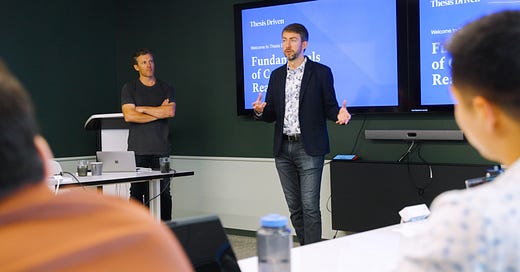Fundamentals of Commercial Real Estate is Now Online
Thesis Driven's first virtual bootcamp teaching the fundamentals of real estate starts September 23rd
Earlier this year, Paul Stanton and I began teaching the basics of the real estate industry through our Fundamentals of Commercial Real Estate course. Since February, we’ve run live bootcamps in New York City serving a mix of proptech employees, aspiring real estate operators, brick-and-mortar entrepreneurs, and more.
Starting this month, we’re offering the course in a virtual format. And we’re keeping the best aspects of the in-person course, with a focus on limited class sizes, 1:1 interaction, practical application, and learning in the context of a community of peers over a five-week bootcamp. You can go here to learn more and sign up.
What is the course?
Thesis Driven’s Fundamentals of Commercial Real Estate course was built to help people working with the real estate industry who lack traditional real estate backgrounds. This includes:
Proptech founders and employees;
Brick-and-mortar operators;
People at real estate firms without real estate backgrounds—e.g., data scientists and architects.
We take a case-based learning approach around a fictional mixed-use project, Harbor Yards—a mostly vacant, 200,000 square foot office complex being redeveloped into a mixed-use community with office space, retail, and apartments. It follows the trials and tribulations of ten characters who acquire, redevelop, operate and sell Harbor Yards over a five-year period.
By understanding each player’s incentives—financial and otherwise—participants will get a practical, hands-on grasp of how the commercial real estate industry works as well as familiarity with key concepts like return metrics (YOC, IRR), GP/LP structures, waterfalls, debt and equity concepts, and more.
How does the online course work?
Most online courses are bad. For most students, sitting at home watching videos by yourself isn’t a great way to learn—and it’s not particularly fun.
We studied other online courses from other industries that actually work and implemented best practices here, including:
Cohorts. Like in our in-person programs, each student is in a cohort of no more than 35 total students, allowing meaningful interaction and collaborative work.
Sync and Async. Good online learning combines asynchronous (on your own time) with synchronous (at the same time) learning. In addition to weekly lessons and content, each cohort will meet synchronously once a week for discussion, questions, and group work.
Practical Application. As with our live program, our online program ends with a capstone project in which students work in small groups to underwrite and develop a business plan for a redevelopment project. This kind of practical application is key for learning.
Community. Learning works best in a group of peers. We’re aiming to keep the best social aspects of our in-person classes, running our programs on Circle and offering an ongoing peer group even after courses finish.
We also try to talk to every prospective student before they sign up. We’ll have to stop doing that at some point, but for now it’s important to us to have a 1:1 touchpoint with every person who joins to ensure they’re a good fit for the program.
Our first online program starts on September 23rd. If you’d like to learn more, you can visit our new courses site to sign up!
—Brad Hargreaves and Paul Stanton






